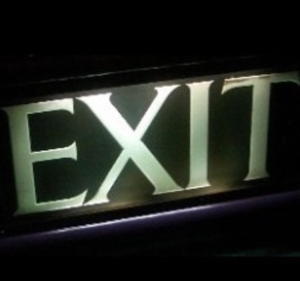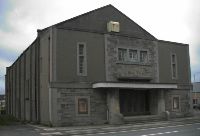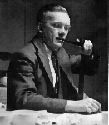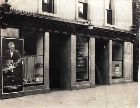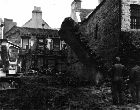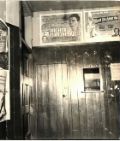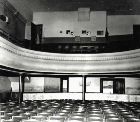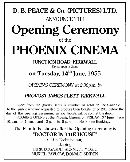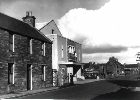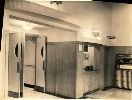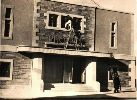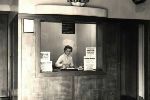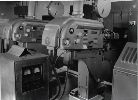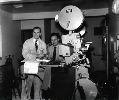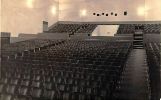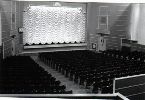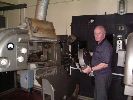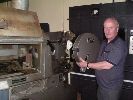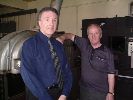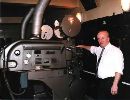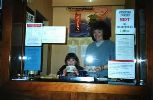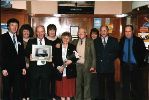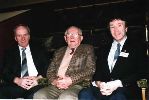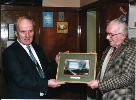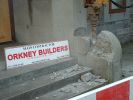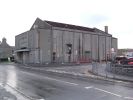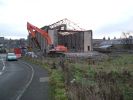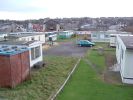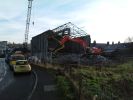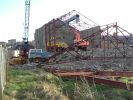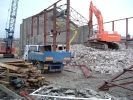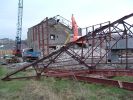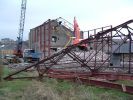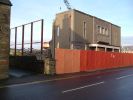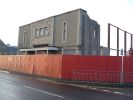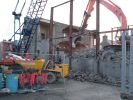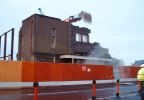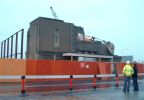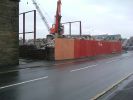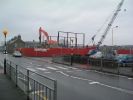Scottish Cinemas and Theatres
Back Main
Back Main
|
The Cinema In Orkney /
Phoenix Cinema
Written and compiled by Kenny Thomson Dedicated to Dougie Shearer and Billy Scollie Billy said that it was sad to see the old place being destroyed as it held so many memories of people – staff and members of the public - many of whom themselves were real characters, perhaps more so than some of the stars we were seeing on the screen.
Entertainment in Kirkwall, even in the memory of our oldest inhabitants, never lacked sophistication. During the 1890s there were the convivial assemblies and in the hey day of Gilbert and Sullivan various groups produced their own operas, which often were laughter making local parodies on the originals. There then followed a graduation from fancy dress balls to charades and eventually magic lantern shows. A new era was beginning and the 20th century mind was devising new ways of entertaining itself, in an atmosphere of scientific progress. D. B. Peace, a Kirkwall cabinetmaker, was aware of the craving for modern entertainment within the generation of young folk who were growing up around him and he began to look at ways of satisfying the need. He was aware that in the south, roller skating was all the rage and of course youthful exuberance called for an active pastime. With this in mind, he converted his Junction Road wood store into a roller skating rink in 1910. Two professional instructors taught the patrons the intricacies of their art. Round and round they whirled on the fine maple wood floor, the graceful and the clumsy, tumbling and colliding, with the clattering of their roller skates drowned out by the music of the brass band. Four years later, while storm clouds were gathering over Europe, a wonderful ‘new art’ was developing. Visitors to Orkney were telling marvellous tales about the animated pictures which they were seeing. Some Orcadians had of course already seen moving pictures on the silver screen, as during the late 1800s, a mobile cinema operated by a man named Calder, had come to Orkney generally round about the time of the Lammas Market and this was continued for a short time by a Mr Bell. On the big bright screens, the early stars including Charlie Chaplin, complete with his stick and bowler hat, were waging an irresistably comic war. Another war was beginning in Europe as the Kaiser was preparing to invade Belgium and in the midst of it all, Mr Peace was taking home to Orkney his first movie projector, a ‘Gaumont’ machine.
For fourteen years The Electric Theatre - with D. B. Peace senior himself as projectionist, later to be joined in the 1920’s by J. W. Sinclair (Jimmy Halfo) - was the most popular place of entertainment in Kirkwall, with unbelievable dramas and tear jerking cinema moralities flickering over the screen. To the delight of the threepenny seats (a penny - halfpenny at matinees), cowboys and Indians began to make their appearance and in simple sagas of good and evil, the children quickly began to distinguish between the ‘goodies’ and the ‘baddies’. There was of course no soundtrack to the films as yet, so the musical accompaniment was provided by pianist Rose Petrie, and Dougie Shearer once recalled that as time passed, he was promoted to the post of ‘Musical Director’, which involved playing the old wind up gramophone at each show, at what he described as a good weekly wage of seven shillings (35p). Even with musical accompaniment for the films, ‘free comment’ from all over the hall followed the fortunes of the actors. As time went by, Dougie's Grandfather paid a visit to the film renters in Glasgow and while he was there he heard about the new Brunswick Panatrope - an Electric Gramophone, ideal for the Electric Theatre which had its own electricity supply from a dynamo powered by a gas generator. The Panatrope was ‘housed’ in a steel case with two turntables, BTH Pickups, 2 volume controls and a change over switch. A technician from Glasgow installed the equipment which was ideal for accompanying the silent films and Dougie would use the music ‘Hearts and Flowers’ for serious love scenes and if there was a chase in the Cowboys and Indians films he used ‘The Storm’ from the William Tell Overture.
The ‘Albert’ performed indispensable service to troops and civilians alike during the war years, with Mrs Shearers tearoom which had been set up within the Kinema, being removed to make way for extra seating to accommodate the vast increase in audience numbers attending the three shows daily - which were helping to counterbalance the grim news in the Press and on the Radio. Christmas Day at The Albert was always a family occasion, enjoyed by youngsters and parents alike and this was the only time of the year when the film start times were governed by the whereabouts of the ‘ba’ game! If the ba was in Albert Street, the patrons could not get in – or out of the Kinema. Just as people were beginning to forget the wild thunder of guns around the ‘Flow’ and the tramp of army boots in Albert Street, a tragedy occurred.
Such was the ferocity of the blaze that there was fear of nearby premises catching light. The business of A. M. Morgan had to move their stock of gun ammunition to safety for fear of explosion. In an hour or so all that was left of The Albert Kinema was a burnt out shell and for the first time since 1914, no one could go to the pictures.
The ordering of films was a task usually carried out by Dougie Shearer, who received film travellers from such distributors as The Rank Organisation, Warner Brothers, British Lion, Columbia Pictures, MGM, Twentieth Century Fox plus some others. Some years ago he recalled with a smile, the time when he had six of the travellers to see in one day. Only the ‘unflappable’ Dougie Shearer could handle such a situation! The arrival of Grampian Television in 1966 had a significant effect on audience figures and to try and counter this, Tuesdays and Fridays were given over to Bingo, which really went against the grain as far as D.B.Peace Jnr. was concerned. The Bingo evenings literally ‘saved the day’ at least for a while and were supervised by Mac Johnston who acted as Bingo Caller and who had agreed to help out temporarily until someone permanent was found. Mac held this ‘temporary’ post for fourteen years! Films were therefore cut to 4 days each week, Monday, Wednesday, Thursday and Saturday. With the advent of colour television in the seventies, the cinema audiences were further depleted, although films such as ‘Grease’, ‘Saturday Night Fever’, ‘Jaws’ and ‘E.T. The Extra Terrestrial’ did excellent business, proving that if the product was good, the people would turn out. Video had appeared on the scene by the early eighties and was almost the final nail in the coffin when film performances were further cut to two nights weekly. This unfortunate downturn continued, leaving the Shearer family no option but to sell the Phoenix in October 1985 to Orkney Islands Council, effectively ending their 73 year association with cinema in Orkney. It seemed apparent at the time, that this was indeed the end of ‘picture going’ in Orkney in general, but a new company was formed called Orkney Entertainments Limited, who indicated their interest in leasing the Phoenix from Orkney Islands Council for the purpose of running film shows twice weekly. The Council supported this proposal and film shows re-commenced during November 1985. At this point it was considered necessary to install a large stage for concerts and this was added in the auditorium at the expense of 100 or so stalls seats. Some time later, the cinemas sound system was upgraded to ‘ultra stereo surround sound’ which significantly enhanced the audio enjoyment for the public. Apart from this, very little changed over the years, the original chandeliers in the foyer were replaced with fluorescent strip lighting, the illuminated flower boxes above the cash desk and shop kiosk were removed and in the projection room, the slide projector which enabled messages to be flashed up on the screen was removed along with a 16mm film projector on which were run the local newsreels filmed by Dougie himself. There were plans to convert the Phoenix into a theatre and transfer the cinema to the Arts Theatre in Mill Street, but this never got off the ground. When Satellite Television came on the go, the commercial viability once again was severely tested and in 1992 Orkney Islands Council Education and Recreation Department itself took control of the film shows and with Billy Scollie as Projectionist / Manager, a regular service continued. Billy had many fond memories of The Phoenix and was especially pleased to be projectionist for the film ‘Venus Peter’, which premiered at The Phoenix on Midsummers day 1989 as part of The St Magnus Festival. Billys favourite films included the 1970’s Sun Classic films starring Dan Haggerty as ‘Grizzly Adams’ and the epic movies such as Ben Hur along with the old westerns and magnificent musicals, all sadly gone from the screens these days. Dougie Shearer, whose favourite film of all time was ‘Singing In The Rain’, maintained an interest in and was a regular visitor to the cinema even after it was sold to Orkney Islands Council. The Phoenix had screened over 5,000 films in its 43 years and topping the charts as the number one film was Grease which attracted an audience of 4,220 on its first run in September 1978, beating the previous best for Jaws in April 1977. Over the years many well known personalities have graced the Phoenix stage: Robert Wilson, Jimmy Shand, Jim Macleod, The Corries, Bridie Gallagher, Ruby Murray, Edwin Heath (Hypnotist), Boxcar Willie, Susan McCann, Philomena Begley, Hank Locklin, Manson Grant and The Dynamos, Colorado, the 114 strong National Youth Orchestra of Scotland, Boxing and Wrestling Matches, plus the ever popular Miss Orkney Talent Contests, and in more recent years, Del Amitri, The Indians, Billy Connolly and Barbara Dixon, but to name just a few. Many local bands made their first appearance at The Phoenix and went on to greater things.
Prior to the final show, Dougie Shearer on behalf of The Phoenix Staff, presented the Projectionist / Manager Billy Scollie with a framed photograph of the cinema auditorium taken by Mr W. Marr prior to its opening in 1955.
At the farewell concert James Oliver Alexander paid a very fitting tribute to the Phoenix:-
Footnote The signs which were originally
above the door of The Electric Theatre which opened in 1914 have been
sympathetically restored by Mr Harold Esson from Dounby and at Dougie
Shearers request these signs are now on display at Harolds museum.
Additional photos of the Phoenix can be seen here. |
Back Main
Unless otherwise
specified, all photographs and other material copyright (c) 2001
- 2020 Gordon Barr and Gary Painter.
All rights reserved. Permission for use elsewhere normally granted, but please ask first!
No attempt is made to infringe any existing copyrights or trademarks. Please contact the editors in case of any queries.
All rights reserved. Permission for use elsewhere normally granted, but please ask first!
No attempt is made to infringe any existing copyrights or trademarks. Please contact the editors in case of any queries.
